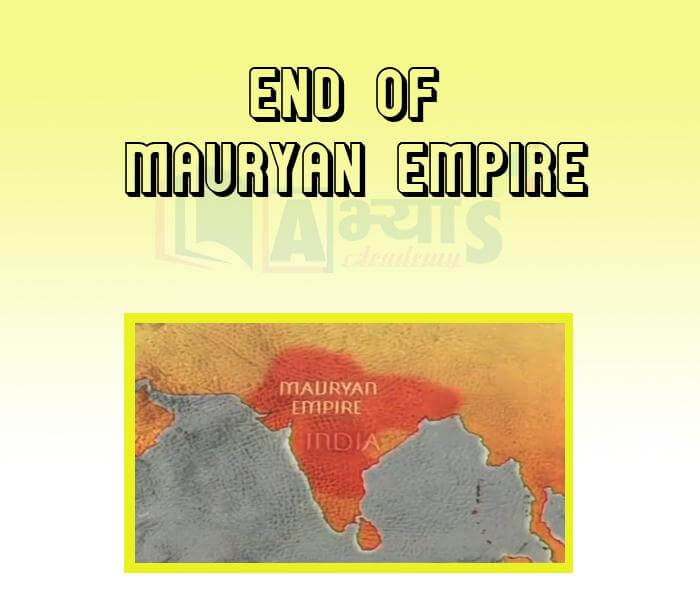End of Mauryan Empire












End of Mauryan Empire
The End of the Empire: Ashoka ruled for about 37 years, and the empire continued for another 50 years. After that, the empire began to break up. Many reasons are suggested for this. The administration might have become less efficient; or it might have become financially difficult to run such a vast empire. Or perhaps the army had become weak due to the policy of peace followed by Ashoka. The final blow was given by the Sungas, who took over the throne of Magadha from the Mauryas.
The Maurya empire was finally destroyed by Pushyamitra Shunga in 185 BC. Although a brahmana, he was a general of the last Maurya ruler called Brihadratha. He is said to have killed Brihadratha in public and forcibly usurped the throne of Pataliputra. The Shungas ruled in Pataliputra and central India.
There are some reason of fall of Mauryan empire.
1 Brahmanical Reaction: he brahmanical reaction began as a result of Ashoka’s policy. There is no doubt that Ashoka adopted a tolerant policy and asked the people to respect even the brahmanas, but he issued his edicts in Prakrit and not in Sanskrit. He prohibited the killing of birds and animals, and derided superfluous rituals performed by women.
The anti-sacrifice attitude of Buddhism adopted by Ashoka adversely affected the incomes of brahmanas. Further, Ashoka appointed rajukas to govern the countryside and introduce vyavaharasamata and dandasamata. This meant the same civil and criminal law for all varnas. But the Dharmashastra compiled by the brahmanas prescribed varna discrimination. Naturally this policy infuriated the brahmanas.
2 Financial Crisis: The enormous expenditure on the army and payment to the bureaucracy created a financial crisis for the Maurya empire. As far as we know, in ancient times the Mauryas maintained the largest army and the largest regiment of officers. Despite the range of taxes imposed on the people, it was difficult to maintain this huge superstructure. It seems that Ashoka made large donations to the Buddhist monks which left the royal treasury empty. Towards the end, in order to meet expenses, they were obliged to melt gold images.
3 Oppressive Rule: Oppressive rule in the provinces was an important cause of the break-up of the empire. In the reign of Bindusara, the citizens of Taxila bitterly complained against the misrule of wicked bureaucrats (Dushtamatyas). Their grievance was redressed by the appointment of Ashoka, but when Ashoka became emperor, a similar complaint was made by the same city.
4 New Knowledge in the Outlying Areas: We may recall that Magadha owed its expansion to certain basic material advantages. Once the knowledge of the use of these elements of culture spread to central India, the Deccan, and Kalinga as a result of the expansion of the Magadhan empire, the Gangetic basin, which formed the heart of the empire, lost its special advantage. The regular use of iron tools and weapons in the peripheral provinces coincided with the decline and fall of the Maurya empire.
Students / Parents Reviews [10]
My experience was very good with Abhyas academy. I am studying here from 6th class and I am satisfied by its results in my life. I improved a lot here ahead of school syllabus.

Ayan Ghosh
8thMy experience with Abhyas is very good. I have learnt many things here like vedic maths and reasoning also. Teachers here first take our doubts and then there are assignments to verify our weak points.

Shivam Rana
7thOne of the best institutes to develope a child interest in studies.Provides SST and English knowledge also unlike other institutes. Teachers are co operative and friendly online tests andPPT develope practical knowledge also.

Aman Kumar Shrivastava
10thBeing a parent, I saw my daughter improvement in her studies by seeing a good result in all day to day compititive exam TMO, NSO, IEO etc and as well as studies. I have got a fruitful result from my daughter.

Prisha Gupta
8thIt has a great methodology. Students here can get analysis to their test quickly.We can learn easily through PPTs and the testing methods are good. We know that where we have to practice

Barkha Arora
10thIt was good as the experience because as we had come here we had been improved in a such envirnment created here.Extra is taught which is beneficial for future.

Eshan Arora
8thAbout Abhyas metholodology the teachers are very nice and hardworking toward students.The Centre Head Mrs Anu Sethi is also a brilliant teacher.Abhyas has taught me how to overcome problems and has always taken my doubts and suppoeted me.

Shreya Shrivastava
8thAbhyas Methodology is very good. It is based on according to student and each child manages accordingly to its properly. Methodology has improved the abilities of students to shine them in future.

Manish Kumar
10thIt was a good experience with Abhyas Academy. I even faced problems in starting but slowly and steadily overcomed. Especially reasoning classes helped me a lot.

Cheshta
10thI have spent a wonderful time in Abhyas academy. It has made my reasoning more apt, English more stronger and Maths an interesting subject for me. It has given me a habbit of self studying
